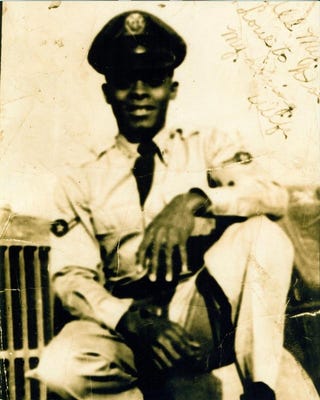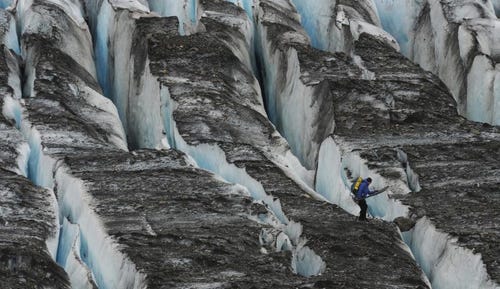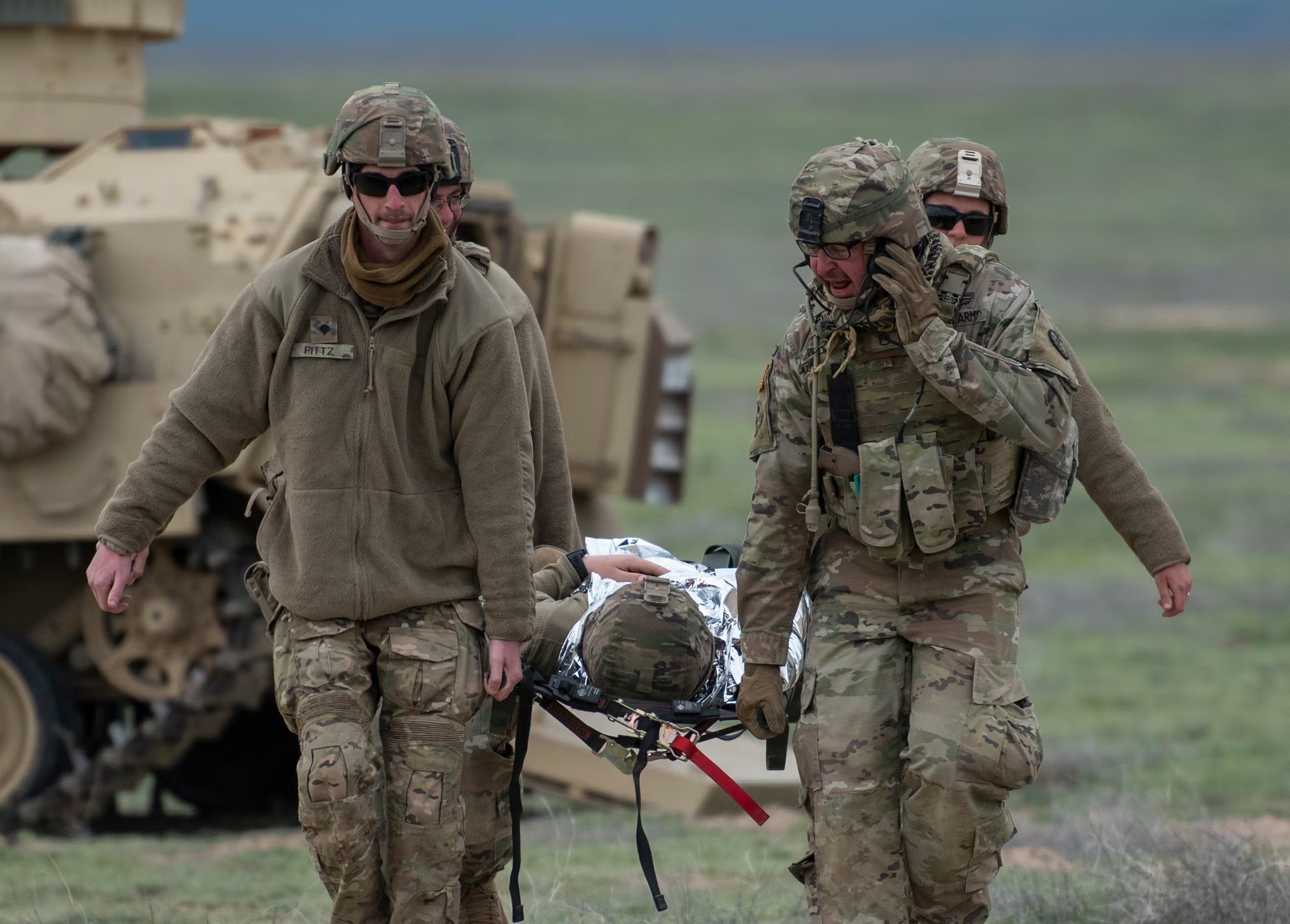source GAIA package: Sx_MilitaryTimes_M6201410307090059_5675.zip Origin key: Sx_MilitaryTimes_M6201410307090059 imported at Fri Jan 8 18:19:03 2016
 Almost 50 years after her husband's death in a military transport plane crash in the mountains of Alaska, Dorothy Anderson was finally ready to accept his flag.
Almost 50 years after her husband's death in a military transport plane crash in the mountains of Alaska, Dorothy Anderson was finally ready to accept his flag.
 The C-124 Globemaster disappeared under an avalanche of rock and snow after flying into a mountain during a winter storm on Nov. 22, 1952. During the numb months that followed, Anderson never gave up hope that her 22-year-old husband survived the accident — even though there was no tangible evidence otherwise. None of the bodies of the 52 service members on board were recovered.
The C-124 Globemaster disappeared under an avalanche of rock and snow after flying into a mountain during a winter storm on Nov. 22, 1952. During the numb months that followed, Anderson never gave up hope that her 22-year-old husband survived the accident — even though there was no tangible evidence otherwise. None of the bodies of the 52 service members on board were recovered.
For decades, the plane and the men it carried seemed all but forgotten by everyone except by those whose lives, like Airman Basic Isaac Anderson's widow, had been irrevocably changed by the tragedy in the midst of the Korean War.
When Dorothy Anderson's grown granddaughter asked in late 1999 if she might try to obtain her grandfather's ceremonial burial flag, the aging widow, who never remarried, said yes.
Tonja Anderson-Dell had grown up hearing only fragments of her grandfather's story. For years, her grandmother had shut down when Tonja asked about him. Tonja's own father, Isaac Jr., was just 1½ years old when he lost his airman dad.
Finally having her grandmother's blessing, Tonja wasted no time in her quest to obtain the flag — and as much information as she could about the crash that claimed the grandfather she never met.
She couldn't have imagined that the ill-fated Globemaster would show itself in a shifting Alaska glacier in 2012, a dozen years after she set out on her search — or that she would form links with some of the families of the 17 whose remains finally made it home in June.
'Instant death'
Isaac Anderson, a native of Tampa, Florida, joined the Air Force at the outset of the Korean War as a way to support his family. He was a senior vehicle operator assigned to the 625th Aircraft Control and Warning Squadron at Elmendorf Air Force Base, Alaska, when he came home on leave in October 1952.
It had been more than a year since he had been home, and the young father didn't want to go back. His wife wrote letters to his leadership asking for a leave extension.
The requests were denied, and Anderson headed back across the country.
Dorothy Anderson was listening to the radio in her Tampa kitchen when she heard news that a military plane headed to Elmendorf from McChord Field, Washington, had gone missing.
"She had a gut feeling it was his," Tonja said.
This is what an emotional Dorothy Anderson related to her granddaughter 15 years ago.
Tonja now had the information she needed to begin her research in earnest while waiting on the flag. She tracked down old newspaper stories and the 300-page accident investigation report from the crash.
The newspaper articles provided an almost daily accounting of the early efforts to reach the wreckage and retrieve the remains of the 11 crew members and 41 passengers who, according to one Anchorage Daily News story, "met an instant death" when the Globemaster struck Mount Gannett at full speed.
A search crew reached the mountain peak days after the crash and found the plane "almost completely covered by snow." The searchers identified the plane by its tail number and made plans to recover the bodies by helicopter, on foot and by barge. The plan, considered too treacherous, was abandoned, according to the news accounts. But by Dec. 9, a secondground party reached the site.
It is not clear what happened after that.
One person writing in the Dec. 2, 1952, crash report indicated recovery of the bodies was possible "if one is willing to spend enough energy, time and money on it. ... It is a question, in my opinion, whether the objectives are worth x number of dollars and energy," the report stated.
As Tonja read those words, she believed something might still be done to bring her grandfather and those who'd died with him home.
Search for answers
Tonja began a letter-writing campaign that spanned more than a decade.
When her grandmother died in September 2001, just two months before the flag that started Tonja's search finally arrived, Tonja's work came to a momentary halt.
"For a little while my heart was broken," Tonja said. "I told myself, 'I'm here. I still want to know what happened.' "
She wrote to members of Congress and to Presidents George W. Bush and Obama, telling the latter that neither she nor her father would vote for his re-election if he failed to respond. He, like most politicians she reached out to, did.
Since the Globemaster had been carrying airmen, soldiers and sailors, she penned letters to each of the military branches asking for information. She searched, unsuccessfully, for members of his squadron, wrote the casualty department of the Air Force, posted messages on social media and other online forums.
"I posted everywhere I could post," she said.
Tonja created a website at www.findingthosewelost.com, where she scanned in the newspaper articles and the two remaining photographs of her grandfather. Airman Anderson wears his uniform in both. In the first, he relaxes in the sunlight, his left arm resting on his knee. In the second, a professional portrait taken during that last trip home, he poses with his young wife.
"I often wonder what type of grandfather he would have been," Tonja wrote on her website, "the stories he would tell about his days in the USAF."
In 2010, she started a Facebook page called "C124 Crash" in the hopes of connecting with the families of other victims. They found her: widows and siblings and children and grandchildren who, like Tonja, never stopped wondering.
Sandra Kozak was widowed at age 17 with an infant daughter when Army Private Leonard Kittle perished in the crash.
Stephen Seeboth grew up hearing about his Uncle Buddy — Navy Commander Albert Seeboth — and joined the Navy himself.
Jerry and Fred Hoblit both named children after their father, Air Force Col. Noel Hoblit, who was away from his family for much of the duration of World War II. The father and 16-year-old Jerry were making up for lost time in 1952 when the colonel boarded the Globemaster and never came back. Also left behind was 6-year-old Fred.
Tonja exchanged messages and phone calls with many of them, passing on the information she had gleaned.
Discovery
Then, on June 10, 2012, just months away from the 61th anniversary of the crash, nature uncovered what all of Tonja's work could not: aircraft wreckage.
An Army National Guard unit on a Black Hawk training mission spotted it from the air. Closer inspection determined it was the long-lost Globemaster.
Visibility the night of the crash had been so bad, Elmendorf historian Douglas Beckstead said in a 2012 Defense Department video, it was like flying inside a light bulb.
"No perspective, no view of anything around the plane, above the plane … it literally flew right into the side of the mountain," Beckstead said.
The crash was, as one can imagine, catastrophic, obliterating the plane into small pieces that came to rest on Colony Glacier.
That glacier had been slowly moving for six decades. By the time the Guard crew spotted it, the wreckage had traveled 12 miles from the place of impact.
Army Staff Sgt. Joshua Richardson, a Northern Warfare Training Center Mountaineering instructor who searched Colony Glacier for debris in 2012, described it in another DoD video at the time: "All the pieces are getting crushed and milled through the glacier as it moves through the ice and rocks … small pieces become smaller."
An eight-person team from the Joint POW/MIA Accounting Command flew to the glacier to collect human remains, thus beginning the painstaking process of identification that officials said then could take months — or even years.
"It's not 'CSI.' It's not 'Bones,' " forensic anthropologist Gregory Beck said in DoD interview a month after the discovery. "You don't have remains and get to solve the case in an hour."
The military didn't keep DNA samples of service members on file in 1952. JPAC would have to track down dental records and surviving relatives for family reference samples to compare to the remains.
"It is lengthy because it is done right and proper," Beck said.
Flyover
Tonja and the others would be in for another wait. But that June, as news of the found plane made headlines, she was overcome with gratitude — and a desire to visit the place where the plane went down.
That September, she traveled from her home in Tampa to Alaska, just as her grandfather had done. She'd fought for so long. Now she had to see what had been found. At Elmendorf, Tonja touched recovered pieces of the aircraft, a raft, a fuel canister, a pack of chewing gum, a hockey puck, the heel of a shoe.
A local pilot flew her along the same route the military transport had taken. As they winged over the icy peaks, a gust of wind caused the small plane to dip suddenly. It was just above the place where the Globemaster had come to rest.
Tonja realized it might be the closest she'd ever come to her grandfather.
Search continues
The news came in April. Airman Anderson's remains were not among the 17 JPAC had identified.
For a little while, Tonja's heart was broken again. But she found comfort in her mother's words: "If God had given you your grandfather with the first 17, would you still be able to fight for the remaining 35?"
It's what she intends to do. She lost her 17-year job as an operations manager last year and now, at age 43, has more time to focus on the search for her grandfather.
Black Hawk teams, she said, are supposed to fly over the crash area again this month in search of any newly uncovered debris. However, if the glacier travels much further — as it most certainly will — the remaining wreckage will fall into a lake. That would make recovery impossible, Jerry Hoblit said. Tonja plans to stay on the military in the hope the others can be found before it is too late.
Last month, the remains of those 17 finally began making their way home.
A hero's welcome awaited Army Private Kittle in Caney, Kansas. Businesses all over town celebrated with signs and banners. American flags fluttered from overpasses. Families came out on porches and front yards to salute his procession to the cemetery, where on June 21 Kittle was buried next to his mother.
The young Army private had been his mother's favorite, said Kittle's daughter, Linda Erickson, and for years her grandmother harbored the hope that her son hadn't been on that plane, or that he'd survived and was living in Canada with amnesia.
Now Kittle was back where he should have always been.
Tonja was there to witness it.
She made the trip to the heartland to pay her respects to a man who'd died alongside her grandfather — and to meet his widow, Sandra Kozak, whose story was so much like Tonja's grandmother's.
Tonja arrived the evening before the funeral. She and Kozak had only ever spoken on the phone, but they recognized each other right away.
They cried as they embraced, havingfound something in all they'd lost.





